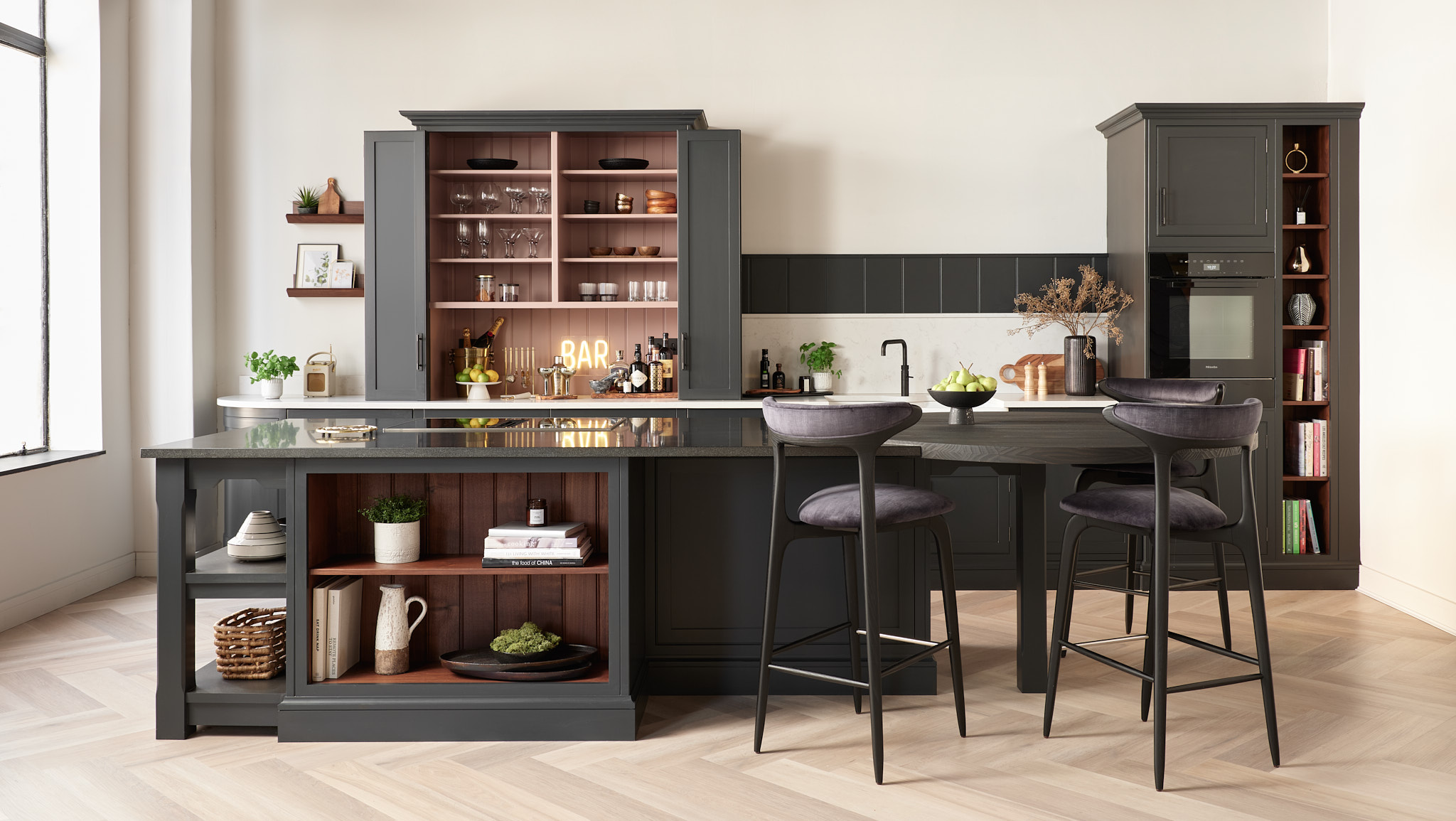
The key aspects of an industrial kitchen include raw, exposed elements, large open spaces and a neutral colour palette. Think concrete grey, matte black and architectural white, as well as some saturated shades of rust orange, brick red and royal blue. Offering a stripped-back appearance, this kitchen design is commonly found in the hospitality sector, however, increasingly homeowners are bringing in industrial touches to a domestic setting, having fallen for its practicality, style and versatility. An industrial kitchen style offers something unique to your home and is always a talking point for visiting guests. When designed correctly, it makes a bold statement that is sure to impress.
Bringing together sleek, clean lines and minimal cosy comforts, the materials used in industrial kitchens are typically designed to fit together seamlessly, and are high-quality, made to last and easy to clean. But, exactly which ones are best for creating a modern industrial kitchen?
Concrete
Concrete is hard-wearing, versatile and practical— an ideal material for an industrial style kitchen. Often bringing to mind converted warehouses, lofts and factories, it can be utilised in a number of ways in your design. Concrete is a very heavy material though, so if this is what you want for your kitchen, consult with a professional first to see if the building structure can withstand its weight.
The material can be used for flooring, countertops and even your walls. Strip back to the basics (without skimping on style) with stained concrete flooring in dark grey or black, or opt for an exposed concrete wall that offers a contemporary look. There are very few areas in the kitchen where it won’t work! You can either have one feature and keep everything else white to create a clean, polished industrial look, or add a few more concrete touches, like countertops or a built-in bench, for example. The key to using concrete effectively is to pair it with softer materials such as wood. Combining textures will add bags of character to your space.
Reclaimed wood
The industrial style is all about combining the old and new to create a fresh design, which makes reclaimed materials ideal. In a world focused on increasing global sustainability, giving old items a new lease of life is unsurprisingly a popular trend in interior design. And due to its natural beauty and durability, reclaimed wood is timeless and a perfect choice here.
A wooden dining table set with chairs, for example, mixed with other industrial elements like neutral shades and commercial fittings, helps to create a clean, professional look. Wood is also excellent for your countertops, contrasting well with grey stainless steel and concrete, though it does require a little more maintenance than a marble or quartz surface. Another simple industrial change you can make is to switch your cabinet handles for reclaimed wood. You could even make your own shelves and storage containers if you’re confident in your DIY skills. It’s also a striking material for a kitchen island, if you prefer to steer away from the modern gloss style cabinetry.

Steel
Stainless steel is a common material used in industrial design and is the perfect fit for an aspiring chef. Think of a professional kitchen in the hospitality industry: these often feature strong, durable and commercial steel appliances. This material is not only the most robust option for your oven and fridge, but it can be used for your walls and worktops too, ramping up the industrial appeal. It works with the traditional neutral colour palette, including dark grey and black, while the reflective surfaces of stainless steel appliances can also make your kitchen appear larger. To see the material in action, take a look at our modern white shaker kitchen with a large stainless steel fridge freezer and oven, as well as a matching chrome toaster and kettle.
For an authentic industrial look, opt for heavy-duty appliances so your kitchen resembles a commercial one. These items should be functional, sustainable and incorporate durable finishes and surfaces. It’s worth dedicating a chunk of your budget to your oven, fridge and freezer to pull together the industrial style.
Aside from the bulky goods, you can incorporate some industrial style kitchen accessories too. Metal floor lamps for industrial style lighting make a strong statement and help set the tone, while you can mismatch your bar stools, using both steel and wooden styles to satisfy the colour palette and add more interest. Don’t forget your smaller appliances too. If you’re a baker, for example, invest in a stainless steel standing mixer, or a pasta maker if you’re an Italian cuisine lover. Our industrial inspired family space, which is painted in royal navy, features metallic touches, stainless steel and mixed material seating — conforming with the design standards.
Brick
Stripped back walls, showing off the bare elements, are a key ingredient in an industrial design. If you’re blessed with any brick walls, leave them exposed to make an architectural statement and preserve the natural aesthetic. Exposed brick offers an unfinished yet stylish look that’s fitting for your industrial kitchen design. The rough textures blend with the smooth stainless steel appliances, helping to bring together the colour palette of greys, blacks and saturated colours. Check out this open plan shaker kitchen design, which features exposed brick complemented by steel components.
Exposed brick walls are perfect for introducing an industrial feel, enabling you to create a modern and urban aesthetic. Utilising this material brings together the neutral colour palette, as the red bricks incorporate the rusty tones that are so commonly used in industrial inspired kitchens. However, even without any raw brickwork to expose, you can create the same look by using brick cladding or wallpaper.

If you want some additional guidance on designing your own industrial style kitchen, our team is happy to help. Get in touch with us or visit a showroom today.






